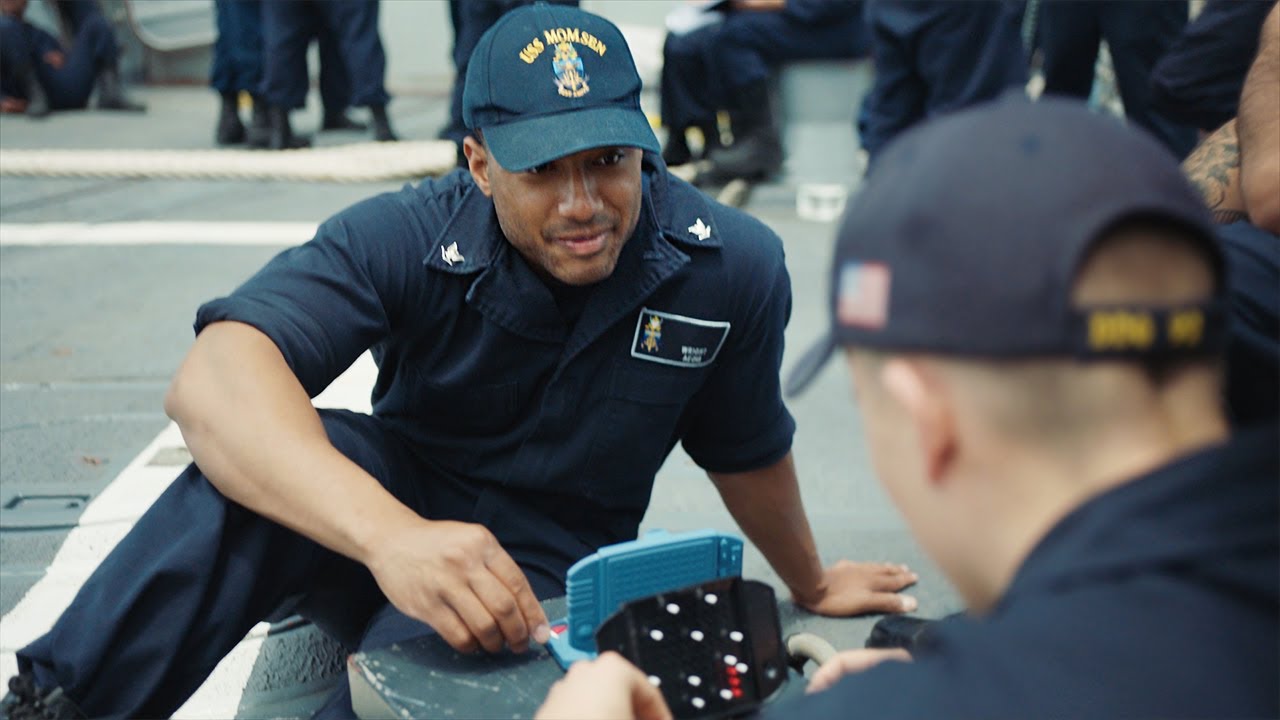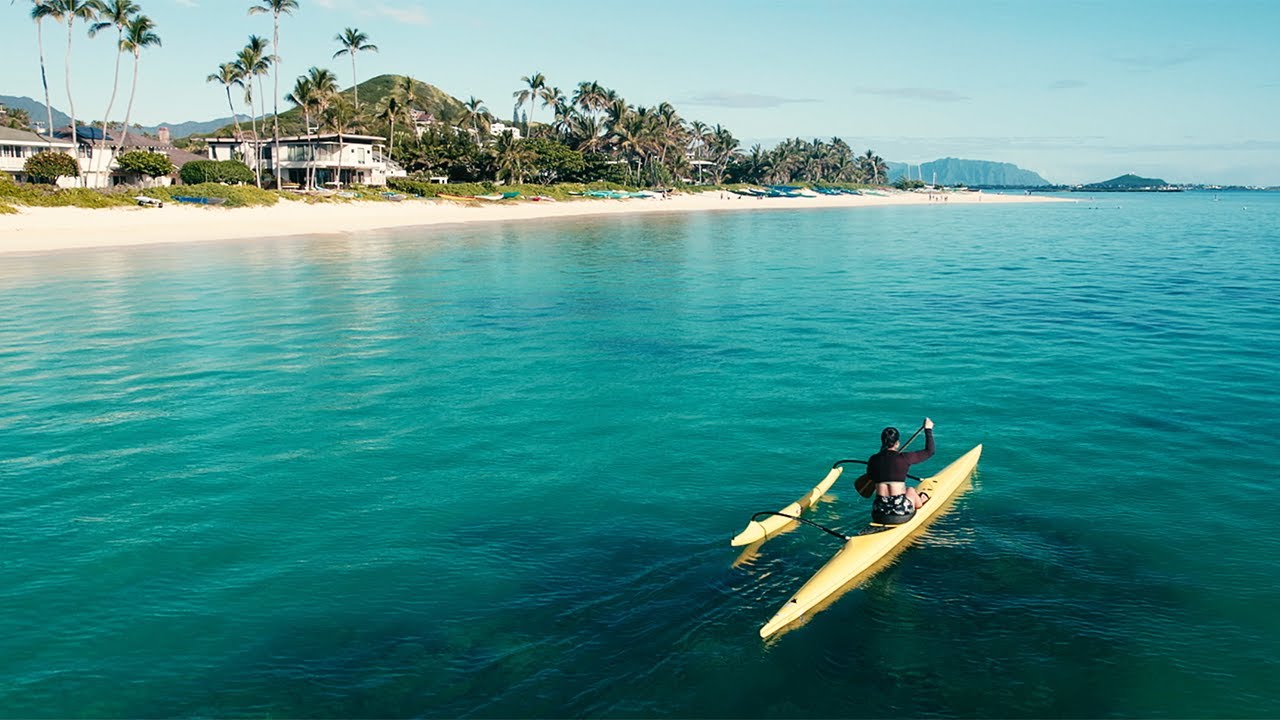Discover what it’s like to actually live and work in America’s Navy, from real Sailors who serve every day. Here we provide insights into where you'll live, what you'll wear, how you'll spend your free time and what it takes to stay physically fit according to Navy standards.
Life on a Navy Base
More Info
Whether on base or at sea, America’s Navy takes pride in providing outstanding living quarters for its Sailors. While on base, you’ll have three living options: Whether living in a barracks (buildings similar to college dorms), an apartment or a house, you’ll have many of the same amenities as civilians, such as full kitchens, recreational areas, laundry facilities and gyms. Navy housing can also accommodate families. Navy living quarters typically come unfurnished with the exception of a stove and refrigerator. Most utilities are already paid. Navy housing on base often includes three or four bedrooms, boasting amenities such as garages, porches and spacious yards. Whether on a ship or submarine, Sailors are provided with sufficient living spaces. The berthing area allows you an area for storage and an assigned rack for sleeping. The cooks in the kitchen (galleys) constantly prepare food for the servicemembers onboard. Mess decks provide a place for recreation and meals. Crew lounges serve as a place for Sailors to kick back and watch TV or play games. Many vessels have ATMs, internet connectivity, and postal services so those aboard the ship can keep in contact with friends and family back home.
Living Quarters
LIVING QUARTERS ON BASE
LIVING QUARTERS AT SEA
The Navy enforces several personal care policies, including how you can dress when off duty and what kind of body art and piercings you can show. There are also basic guidelines for grooming, facial hair and haircuts. A: While buzz cuts are not necessary, males are obligated to keep their hair neat, clean and well-groomed. The bulk of your hair cannot exceed approximately two inches. A: Yes, you can color your hair, but it must look natural and complementary. A: Yes, sideburns are allowed as long as they are neatly trimmed and tailored in the same manner as your haircut. A: Your face must be clean-shaven, unless a shaving waiver is authorized by your Commanding Officer for medical reasons. Beards and goatees are not permitted, though mustaches are authorized as long as they are kept neat and closely trimmed. A: You can wear a wig or hairpiece while in uniform or duty status as long as it’s a natural hair color and appearance. For specific questions, please reach out to your local Recruiter. A: Women reporting to Recruit Training Command (RTC) or Officer Training Command (OTC) are no longer required to cut their hair, as long as they comply with the Navy grooming regulations. Once at RTC or OTC, you will be taught how to maintain your preferred hairstyle in a manner that meets grooming standards for daily wear in the Navy. Women who have specific questions about grooming and hair styles should consult their recruiter. A: You will be obligated to keep your hair neat, clean and well-groomed. Your haircut and style should present a balanced appearance. Ponytails and braids are allowed as long as the ends do not fall more than 3 inches below the edge of your uniform collar. Locks are allowed as long as they fall above your collar. Wearing your hair down is only permitted when in Dinner Dress Uniform. Pigtails and braids that are widely spaced or protrude from the head are not permitted. A: Yes, you can color your hair, but it must look natural and complementary. A: You are not permitted to have beads or any other decorative items braided in your hair. You can wear a maximum of two small barrettes, combs and/or clips as long as they are similar to your hair color. Additional matching bobby pins or rubber bands may also be used to hold your hair in place, if necessary. Fabric elastic bands are not authorized. A: You can wear a wig or hairpiece while in uniform or duty status as long as it’s a natural hair color and appearance. For specific questions, please reach out to your local Recruiter. A: Cosmetics may be applied in good taste so that colors blend with your natural skin tone and enhance your natural features. You may wear lipstick and nail polish as long as the colors are complimentary and conservatively worn. You are not permitted to wear long false eyelashes while in uniform. A: Yes. The Navy has the most accepting tattoo policy of any military branch. In fact, Sailors have a long history of getting tattoos to symbolize milestones within their Navy careers. See Requirements to Join for full details. A: Body piercings, brandings and intentional scarring considered excessive or eccentric are prohibited. Some examples are: A: You are prohibited from any use of gold, platinum or other veneers or caps for purposes of ornamentation. Your teeth, whether natural, capped or veneer, cannot be ornamented with designs, jewels, initials, etc. A: Your clothing must be in good taste, clean, in good repair and pressed. You must ensure your appearance is appropriate for the occasion. Profanity, pornography or references to drug usage on clothing is not allowed. Clothing cannot be sexually provocative or suggestive, depict racial comments or vulgarities, or display offensive language. Undergarments may not be exposed at any time. Tank top shirts, white or tie-dyed undershirts, cut-off shorts, and shower sandals are appropriate attire only for occasions such as picnics, athletic events and other daytime events of an extremely casual nature. A: You can wear civilian clothing anytime you are off-duty ashore. This includes evenings, weekends, when on leave or liberty, or even when leaving or returning to ships or stations. A: You may wear only articles of the military uniform that do not present a unique marking or a distinct Naval appearance, such as certain jackets, shoes, socks, gloves, and underwear, with civilian attire.
Personal Care
MEN'S GROOMING
Q: What kind of haircut can I have? Do I have to wear a buzz cut?
Q: Can I have my hair colored?
Q: Can I wear sideburns?
Q: Am I allowed to have facial hair, such as a beard or mustache?
Q: Can I wear a wig or hairpiece?
WOMEN'S GROOMING
Q: Do I have to get a haircut at Boot Camp or Officer Training?
Q: What kind of haircut can I have? Can I wear my hair in a ponytail or have braids?
Q: Can I have my hair colored?
Q: Can I have beads or other materials in my hair? What about clips and bobby pins?
Q: Can I wear a wig or hairpiece?
Q: Can I wear makeup or other cosmetics?
BODY ART & ORNAMENTATION
Q: Can I have a tattoo or any other body art?
Q: Can I have any body piercings?
Q: Can I have any dental ornamentation (i.e., caps, veneers, etc.)?
OFF-DUTY DRESS
Q: What kind of clothing can I wear when off-duty?
Q: When and where can I wear civilian clothing?
Q: Can I wear any pieces of my uniform when off-duty?
Enlisted Sailors and Officers are hardworking and dedicated individuals, but that doesn’t mean it’s all work and no play. America’s Navy offers several travel and recreational opportunities, as well as generous vacation time. In the Navy, you’ll have the chance to travel, even when not embarked on a ship. With 30 paid vacation days each year, you can use this time to relax, visit your family or venture to new places. Downtime here isn’t much different than in the civilian sector. The Navy offers on-base sports at all skill levels for men's, women's and co-ed competitions. Many tournaments and leagues are offered on a year-round basis for anything from softball to flag football, basketball to volleyball, soccer to tennis, racquetball to running, and much more. The Navy stresses the importance of fitness every day to its members. No matter where you serve, you will find some of the best fitness and workout centers in the world. These facilities and programs promote personal, physical and mental excellence, as well as meet leisure needs and help develop positive lifestyle habits. You may also participate in strength and weight training, cardiovascular conditioning, aerobic and martial arts classes, spinning and yoga. Whether it’s a live concert, a comedy show or the latest Hollywood blockbuster, America’s Navy has plenty to keep you entertained while at sea or ashore. The Navy’s Information, Tickets & Tours (ITT) Program offers information and discount tickets for a wide variety of national, regional and local attractions. This can include passes to an assortment of things like: The ITT office also arranges sightseeing trips and tours within local communities. The Navy also has its own Motion Picture Service, providing movies to hundreds of locations worldwide. More than 150,000 copies of movies are distributed annually, with an inventory of 500,000 videos to choose from. The importance of family takes center stage in America’s Navy. From child development and youth programs, to discounted travel and tickets, to theme parks and camping areas, the Navy is always working hard to ensure your family has every opportunity it would have in the civilian sector. The Navy offers a year-round recreation and sports program, designed to foster social interaction among peers, physical fitness, an interest in the community and the development of positive lifelong recreational skills. The Youth Recreation Program offers many activities and events, including: Other youth programs may also be offered on base: Naval Sea Cadets and Navy League Cadets, Girl Scouts, Boy Scouts and Cub Scouts. The Navy provides affordable, accessible and quality child care for preschool-age children in Child Development Centers and Child Development Homes (homes of selected military family members). Full-time, part-time and hourly/drop-in care is available. The National Academy of Early Childhood Programs is the accrediting agency for Navy Child Development Centers. This program provides before and after-school care on base for children in kindergarten through 6th grade.
Navy Base Life
RECREATIONAL SPORTS & FITNESS
ENTERTAINMENT
FAMILY LIFE ON A NAVY BASE
Youth Recreation Program
Child Development Program
School Care Program
Fitness is a big priority in America's Navy. It has many dimensions, ranging from getting in and staying in shape, to meeting job-specific training standards, to being actively involved in sports and athletics. Consider how dramatically Boot Camp can physically transform your body, or how much physical preparation goes into making Navy SEALs so incredibly capable. Whether you're training to become a SEAL or you're just trying to stay active in your free time, the Navy provides a variety of healthy living options to its Sailors. An official evaluation of physical health, ability and endurance, known as the Navy Physical Fitness Assessment (PFA), is conducted twice a year throughout each servicemember’s Navy career. This process begins in Recruit Training (Boot Camp) or Officer Training, and you need to meet established fitness requirements in order to be part of the Navy. Specifically, the PFA consists of a standard medical screening, a Body Composition Assessment (BCA) and the Physical Readiness Test (PRT). Download the Physical Fitness Assessment Checklist to learn more about the process. Servicemembers must first receive appropriate medical clearance prior to BCA and PRT testing. This clearance involves successfully completing the Annual Periodic Health Assessment (PHA), a Physical Assessment Risk Factor Questionnaire (PARFQ) and pre-physical activity questions prior to taking on the actual Physical Readiness Test. Waivers are available under certain conditions. A Navy Recruiter can provide details. Download the Medical Clearance/Waiver Guide for more information. Body composition is determined by height and weight measurements. These are evaluated according to established Navy standards, and in some cases, circumference measurements are also required. Standards and requirements for BCA vary by sex, age, height and weight (waivers are available under certain conditions). A Navy Recruiter can provide details or you can download the Body Composition Assessment (BCA) Guide for more information. The Physical Readiness Test (PRT) is a standard Navy fitness test consisting of push-ups, a forearm plank and a 1.5-mile run. Participants have two minutes to complete as many push-ups as possible. The forearm plank and 1.5-mile run are also timed. Outside of Recruit Training (Boot Camp), general Navy PRT requirements allow for a choice of the timed 1.5-mile run, a timed 500-yard swim, or one of the following events: Performance standards and requirements for PRT vary by sex and age. A Navy Recruiter can provide details or you can download the Physical Readiness Test (PRT) Guide for more information. While fitness is important for all Navy Sailors, it is imperative for those who make up communities such as Special Warfare/Special Operations, which includes SEAL, Special Warfare Combat Crewman (SWCC), Explosive Ordnance Disposal (EOD) Technician, Navy Diver and Aviation Rescue Swimmer (AIRR) professionals. The qualification standards and training programs for these specialties, referred to as Navy Challenge Programs, are far more demanding. Consistent training, flexible workouts and good nutrition are key to any fitness program, especially in the Navy. Often referred to as PT, Navy physical training provides a foundation for all Navy servicemembers. It’s a program that involves integrating exercise into the workweek. Here’s an example of the type of physical activity associated with PT: Download the Navy Command Fitness and Fitness Enhancement Program (FEP) Guide to learn more about Navy physical training. In the Navy, exercise-related activities can happen anywhere, from a state-of-the-art gym, to an open field, to the flight deck of an aircraft carrier. Workouts can encompass everything from muscular fitness training, to agility fitness training, weight lifting and cardiovascular conditioning. Facilities and resources are always accessible, whether you’re on base or on deployment. Following proper nutritional guidelines is integral to any physical fitness regimen. Whether looking to improve performance, body composition or general well-being, the Navy is committed to helping servicemembers reach your goals. Download the Navy Nutrition Resource Guide for useful tools, tips and advice. Maintaining optimal fitness is as much a part of “mission readiness” as it is a part of each Sailor’s overall quality of life. The overall Navy Physical Readiness Program ensures that this philosophy is a focus. America's Navy offers a variety of sports opportunities, including: Navy physical training also consists of on-base sports at all skill levels for men's, women's and co-ed competitions. Many tournaments and leagues are offered on a year-round basis for anything from softball to flag football, basketball to volleyball, soccer to tennis, racquetball to running, and much more. To learn more, go to All-Navy Sports where you'll find Navy Sports calendars, answers to frequently asked questions and information on how to apply to participate. COLLEGIATE ATHLETICS Interested in Navy Athletics at the collegiate level? Look into the United States Naval Academy (USNA), and get details on USNA Athletics.
Fitness & Sports
PHYSICAL TRAINING
NAVY PHYSICAL FITNESS ASSESSMENT (NAVY PFA)
STANDARD MEDICAL SCREENING
BODY COMPOSITION ASSESSMENT (BCA)
NAVY PHYSICAL READINESS TEST (PRT)
NAVY PHYSICAL SCREENING TEST (PST)
MILITARY PHYSICAL FITNESS PROGRAMS IN THE NAVY
COMMAND PHYSICAL TRAINING (PT) PROGRAM
FACILITIES AND WORKOUTS
NUTRITION
NAVY SPORTS


































































































































